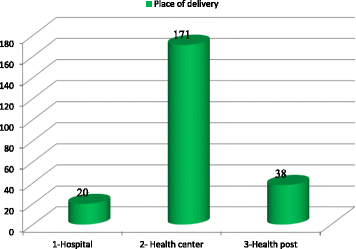Factors influencing institutional delivery service utilization in Dembecha district, Northwest Ethiopia: A community based cross sectional study
- PMID: 28830523
- PMCID: PMC5567650
- DOI: 10.1186/s12978-017-0359-5
Factors influencing institutional delivery service utilization in Dembecha district, Northwest Ethiopia: A community based cross sectional study
Abstract
Background: The risk of death from complications relating to pregnancy and childbirth over the course of a woman's lifetime is higher in the developing countries. Improving the health of mothers and children through well-organized institutional delivery service is central to achieve reduced maternal and child morbidity and mortality. So, factors that underlie the level of institutional delivery service utilization need to be investigated, especially in areas where little is known about the problem. Therefore, the objective of this study was to assess factors influencing institutional delivery service utilization in Dembecha district, Northwest Ethiopia.
Methods: Community based quantitative cross-sectional study was conducted from March 1 to 30, 2015 among 674 mothers who gave birth within the last two years preceding the study using interviewer administered questionnaire. Multi-stage sampling with stratification sampling technique was used. Descriptive statistics were done to characterize the study population using different variables. Bivariate and multivariable logistic regression models were fitted to determine association. Odds ratios with 95% confidence intervals were computed. Statistical significance was declared at p-value <0.05.
Results: Of all 674 respondents, 229(34%, 95% CI: 29.8%-37.9%) of them utilized health institutions for their last delivery. History of still birth (AOR (adjusted odds ratio) =0.25, 95% CI (confidence interval) =0.07-0.77), number of ANC visit (AOR = 38.51, 95% CI = 22.35-66.33), functional media (AOR = 2.61, 95% CI = 1.59-4.28) and distance to nearby health facility (AOR = 0.52, 95% CI = 0.32-0.83) were found to be significantly associated with institutional delivery service utilization.
Conclusion: In this research the level of institutional delivery service utilization is still low compared to government initiatives. History of still birth, low number of ANC visit, unavailability of functional media and existence of distant health facilities were found to be significantly associated with low utilization of the service. So, concerned bodies should contribute their share to improve institutional delivery service utilization in the study area by tackling modifiable risk factors.
Keywords: Associated factors; Dembecha; Institutional delivery; Less than two years; Northwest Ethiopia.
Conflict of interest statement
Ethics approval and consent to participate
The study proposal got ethical approval from Debre Markos University, health science college ethical review committee. Administrative bodies of Dembecha district were asked for their permission of the research to be conducted in the area. Informed oral and written consent was obtained from participants.
Consent for publication
“Not applicable”
Competing interests
The authors declare that they have no competing interests.
Publisher’s Note
Springer Nature remains neutral with regard to jurisdictional claims in published maps and institutional affiliations.
Figures
Similar articles
-
Institutional delivery service utilization and associated factors in Ethiopia: a systematic review and META-analysis.BMC Pregnancy Childbirth. 2020 Jun 15;20(1):364. doi: 10.1186/s12884-020-03032-5. BMC Pregnancy Childbirth. 2020. PMID: 32539698 Free PMC article.
-
Institutional delivery services utilization and associated factors among mothers who gave birth in the last year in Mandura district, Northwest Ethiopia.PLoS One. 2020 Dec 16;15(12):e0243466. doi: 10.1371/journal.pone.0243466. eCollection 2020. PLoS One. 2020. PMID: 33326426 Free PMC article.
-
Factors associated with institutional delivery in Dangila district, North West Ethiopia: a cross-sectional study.Afr Health Sci. 2016 Mar;16(1):10-7. doi: 10.4314/ahs.v16i1.2. Afr Health Sci. 2016. PMID: 27358608 Free PMC article.
-
Knowledge of direct obstetric causes of maternal mortality and associated factors among reproductive age women in Aneded woreda, Northwest Ethiopia; a cross-sectional study.Pan Afr Med J. 2017 May 11;27:32. doi: 10.11604/pamj.2017.27.32.10274. eCollection 2017. Pan Afr Med J. 2017. PMID: 28761608 Free PMC article.
-
The effect of antenatal care on use of institutional delivery service and postnatal care in Ethiopia: a systematic review and meta-analysis.BMC Health Serv Res. 2018 Jul 24;18(1):577. doi: 10.1186/s12913-018-3370-9. BMC Health Serv Res. 2018. PMID: 30041655 Free PMC article.
Cited by
-
Individual, socio-cultural, and health facility factors affecting men's involvement in facility-based childbirth in Southwest, Ethiopia: A mixed method study.SAGE Open Med. 2021 Jun 11;9:20503121211023367. doi: 10.1177/20503121211023367. eCollection 2021. SAGE Open Med. 2021. PMID: 34178338 Free PMC article.
-
Association Between Sociodemographic Characteristics and Assisted Childbirth by Qualified Personnel in Madagascar.J Family Reprod Health. 2024 Dec;18(4):261-268. doi: 10.18502/jfrh.v18i4.17427. J Family Reprod Health. 2024. PMID: 40342648 Free PMC article.
-
Institutional delivery service utilization and associated factors in Ethiopia: a systematic review and META-analysis.BMC Pregnancy Childbirth. 2020 Jun 15;20(1):364. doi: 10.1186/s12884-020-03032-5. BMC Pregnancy Childbirth. 2020. PMID: 32539698 Free PMC article.
-
Institutional delivery service utilisation and associated factors among mothers of childbearing age in Delgi District, Northwest Ethiopia: a community-based cross-sectional study design.BMJ Open. 2022 Aug 29;12(8):e060141. doi: 10.1136/bmjopen-2021-060141. BMJ Open. 2022. PMID: 36038182 Free PMC article.
-
Why do women not use skilled birth attendance service? An explorative qualitative study in north West Ethiopia.BMC Pregnancy Childbirth. 2020 Oct 19;20(1):633. doi: 10.1186/s12884-020-03312-0. BMC Pregnancy Childbirth. 2020. PMID: 33076867 Free PMC article.
References
-
- International online resource centre. [Available from: http://www.asksource.info/resources/search/subjects-resources/mother-chi...]. Accessed 29 Apr 2015.
-
- United Nations Children’s Fund (UNICEF). Progress for Children: A Report Card on Maternal Mortality. New York; 2008. Report No.: 7.
-
- WHO, UNICEF, UNFPA and The World Bank. Trends in maternal mortality: 1990 to 2010. Geneva: World Health Organization; 2010. p. 3. [Available on: http://www.who.int/reproductivehealth/publications/monitoring/9789241503...].
-
- The World Bank. Over 99 percent of maternal deaths occur in developing countries. 2012 [Available from: http://blogs.worldbank.org/opendata/over-99-percent-maternal-deaths-occu...]. Accessed 23 Apr 2015.
-
- World Health Organization (WHO). Maternal mortality. [Available from: http://www.who.int/mediacentre/factsheets/fs348/en/].
MeSH terms
LinkOut - more resources
Full Text Sources
Other Literature Sources
Medical


